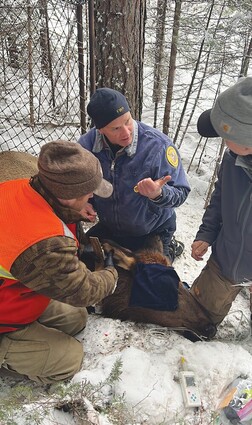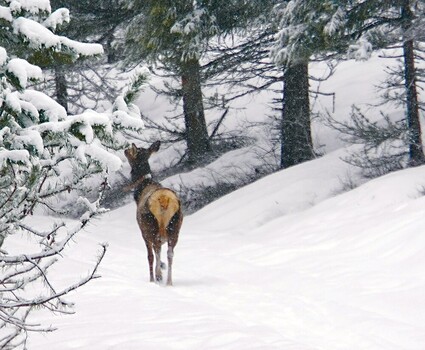FWP studying local elk population
March 9, 2023

Annie Wooden
Region 1 Widlife Manager Neil Anderson (center) works with FWP technicians Brandon Davis (left) and Nate Jourdannais to collect data from a cow elk in Noxon last week.
Montana Fish, Wildlife & Parks (FWP) is conducting a study to learn more about elk in western Sanders County.
In January, FWP staff began setting traps in the Lower Clark Fork region from Whitepine to Heron. The goal was to tag and collar over 60 elk. As of last week, 68 elk had been caught and collared.
Data collected from the study will help FWP better understand what is influencing elk populations. FWP is partnering with researchers from the University of Montana W.A. Franke College of Forestry and Conservation on the project, which will focus on survival, recruitment and pregnancy rates of elk, predator-prey interactions, seasonal distribution patterns on public and private lands, habitat needs and land-use practices that could benefit elk, as well as wildlife management strategies for the region.
"This is an all-encompassing study," said Neil Anderson, Wildlife Manager for FWP in Region 1, which includes Sanders County. "We're going to look at everything that affects elk."
Nate Jourdonnais and Brandon Davis are technicians hired by FWP through the University of Montana. They have been working for weeks to check traps daily and collect data from the elk captured in the traps. Last week, Anderson joined the technicians as they checked traps set, assisting in data collection.
When an elk is caught in a trap, the technicians will tranquilize the animal and then collect blood and fecal samples, as well as a tooth from the elk. The technicians then fit the elk with an ear tag and a collar. The collar gathers the animal's location every 4 hours, Anderson said. Female elk also received a vaginal implant that will help allow FWP to track when and where calves are born.
Last month, FWP spent two days capturing and tagging elk with the aid of a helicopter. Anderson said they were able to collar 34 elk in two days in the helicopter operation.
The study will track the elk for three-four years. Along with seeing where the elk go, Anderson said they will study nutrition and mortality. "This is one of the more complete studies that have been done on elk in Montana," he noted. Anderson added that the information will help other agencies, such as the Forest Service, which makes land management decisions for elk habitat. Elk nutrition will also be studied and technicians will sample vegetation.
Several of the 12 traps were placed on private property. "The land owners have been supportive of the project," Anderson said. "Everybody wants to know what's going on with the elk." Jourdannais said the traps were successful, and one day they caught three separate elk in one trap. Other animals would set off the traps as well. Last Tuesday, a deer had tripped one of the traps in Noxon, but had escaped. The elk are given oxygen while the technicians are collecting data, and monitored after they are released.
Anderson noted that additional elk may be captured as the study progresses to keep the number of collared elk above 60. If a hunter harvests an elk with a collar, the collar can be turned in to FWP.
To follow the progress of this project, visit fwp.mt.gov/aboutfwp/regions/region1.








Reader Comments(0)